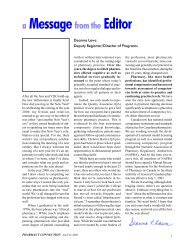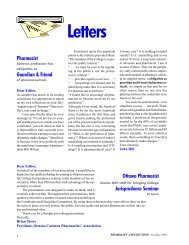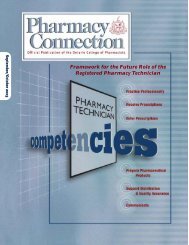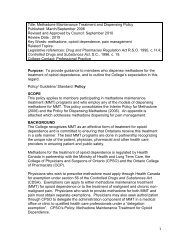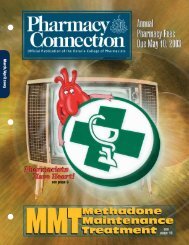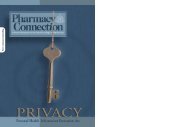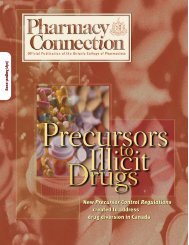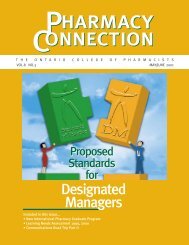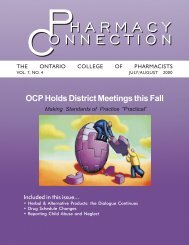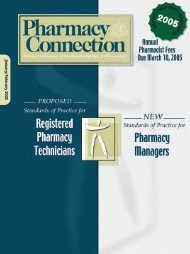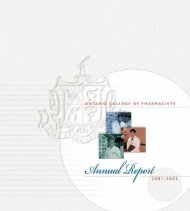Download - Ontario College of Pharmacists
Download - Ontario College of Pharmacists
Download - Ontario College of Pharmacists
Create successful ePaper yourself
Turn your PDF publications into a flip-book with our unique Google optimized e-Paper software.
ISMP CANADA<br />
change and fostering a culture<br />
<strong>of</strong> patient safety in the practice<br />
setting.<br />
Medication Safety<br />
Self-assessment and<br />
Learning from Peers<br />
Policies and procedures <strong>of</strong> individual<br />
pharmacies may differ, but elements<br />
<strong>of</strong> patient care and pharmacy<br />
workflow should be similar to a<br />
certain extent. This allows pharmacists<br />
and pharmacy technicians<br />
to learn from their peers. Consider<br />
the bisoprolol and bisacodyl mix-up<br />
incident described above, it is<br />
conceivable that similar incidents<br />
could occur at any pharmacy. [7] By<br />
reporting this medication incident<br />
to ISMP Canada, the pharmacist<br />
<strong>of</strong>fered the opportunity to other<br />
health care practitioners to learn<br />
from this event. In an effort<br />
to summarize shared learning<br />
from reported near misses and<br />
medication incidents, ISMP US<br />
and ISMP Canada developed the<br />
Improving medication safety in<br />
community pharmacy: Assessing<br />
risk and opportunities for change<br />
(AROC) and the Medication Safety<br />
Self-Assessment® for Community/<br />
Ambulatory Pharmacy TM (MSSA-<br />
CAP), respectively. These risk<br />
assessment tools categorize known<br />
medication safety strategies into<br />
10 Key Elements and 20 Core<br />
Distinguishing Characteristics.<br />
<strong>Pharmacists</strong> can use them to assess<br />
the safety <strong>of</strong> medication practices<br />
in their work settings and identify<br />
opportunities for continuous quality<br />
improvement.<br />
Conclusion<br />
As pharmacists in <strong>Ontario</strong> take<br />
on additional responsibilities, we<br />
must first ensure that we have an<br />
adequate risk management system<br />
in place to strive for patient safety<br />
and medication safety. Pharmacies<br />
can first use the MaPSAF<br />
and PSCQ to assess their safety<br />
culture. Pharmacy managers<br />
can subsequently use Pathways<br />
for Medication Safety®: Looking<br />
Collectively at Risk to devise a plan<br />
for embracing change and enhancing<br />
the cultural competency <strong>of</strong> the<br />
practice setting. Finally, medication<br />
safety self-assessments such as<br />
the AROC from ISMP US and the<br />
MSSA-CAP from ISMP Canada can<br />
help pharmacists learn from each<br />
other and improve the medication<br />
distribution system as a whole. Risk<br />
management is a collaborative and<br />
iterative process. We recommend<br />
using the above CQI tools with all<br />
staff in the pharmacy at least annually<br />
in order to ensure continuous<br />
quality improvement.<br />
Remarks<br />
ISMP Canada Safety Bulletins<br />
(https://www.ismp-canada.org/<br />
ISMPCSafetyBulletins.htm) are<br />
designed to disseminate timely,<br />
targeted information to reduce<br />
the risk <strong>of</strong> medication incidents.<br />
The purpose <strong>of</strong> the bulletins is to<br />
confidentially share the information<br />
received about medication incidents<br />
which have occurred and to suggest<br />
medication system improvement<br />
strategies for enhancing patient<br />
safety. The bulletins will also share<br />
alerts and warnings specific to the<br />
Canadian market place. Complimentary<br />
subscription is available<br />
at https://www.ismp-canada.org/<br />
subscription.htm.<br />
Additional relevant Continuing<br />
Education (CE) opportunities can<br />
be found on page 57.<br />
Acknowledgment<br />
The authors would like to acknowledge<br />
Dilpreet Bhathal, BScPhm,<br />
School <strong>of</strong> Pharmacy, University <strong>of</strong><br />
Waterloo; Analyst, ISMP Canada,<br />
for his assistance in conducting the<br />
literature search for this report.<br />
REFERENCES<br />
1. Medication Incidents Involving Digoxin<br />
Leading to Harm, Including Death. ISMP Canada<br />
Safety Bulletin 2011;11(3):1-3. Available at<br />
http://ismp-canada.org/download/safetyBulletins/<br />
ISMPCSB2011-03-MedicationIncidentsInvolvin<br />
gDigoxin.pdf<br />
2. Ashcr<strong>of</strong>t DM, Morecr<strong>of</strong>t C, Parker D, Noyce<br />
PR. Safety culture assessment in community<br />
pharmacy: development, face validity, and<br />
feasibility <strong>of</strong> the Manchester Patient Safety<br />
Assessment Framework. Qual Saf Health Care<br />
2005 Dec;14(6):417-21.<br />
3. Ashcr<strong>of</strong>t DM, Parker D. Development <strong>of</strong><br />
the Pharmacy Safety Climate Questionnaire: a<br />
principal components analysis. Qual Saf Health<br />
Care 2009 Feb;18(1):28-31.<br />
4. American Hospital Association, Health<br />
Research & Educational Trust, and ISMP.<br />
Pathways for medication safety®: Looking<br />
collectively at risk. 2002. Available at http://www.<br />
medpathways.info/medpathways/tools/tools.html<br />
5. ISMP. Improving medication safety in community<br />
pharmacy: Assessing risk and opportunities for<br />
change (AROC). 2009. Available at http://www.<br />
ismp.org/communityRx/aroc/<br />
6. ISMP Canada. Medication Safety Self-<br />
Assessment® for Community/Ambulatory<br />
Pharmacy TM . 2006. Available at https://www.<br />
ismp-canada.org/amssa/index.htm<br />
7. Concerned reporting: Mix-ups<br />
Between Bisoprolol and Bisacodyl. ISMP<br />
Canada Safety Bulletin 2012;12(9):1-6.<br />
Available at http://www.ismp-canada.<br />
org/download/safetyBulletins/2012/<br />
ISMPCSB2012-09-ConcernedReporting-<br />
BisoprololandBisacodylMixups.pdf<br />
8. Phipps DL, De Bie J, Herborg H, Guerreiro M,<br />
Eickh<strong>of</strong>f C, Fernandez-Llimos F, et al. Evaluation<br />
<strong>of</strong> the Pharmacy Safety Climate Questionnaire<br />
in European community pharmacies. Int J Qual<br />
Health Care 2012 Feb;24(1):16-22.<br />
PHARMACY CONNECTION ~ WINTER 2013 ~ PAGE 37



